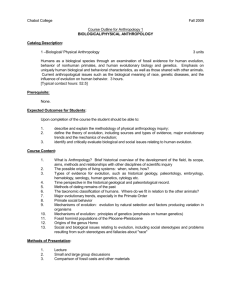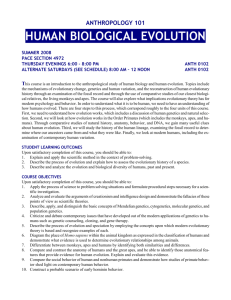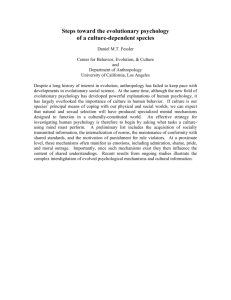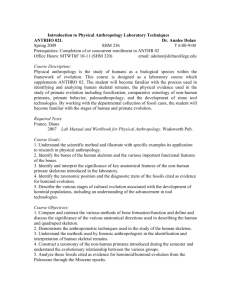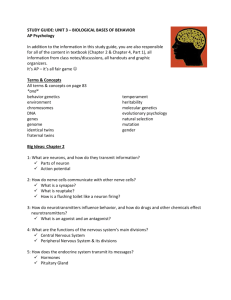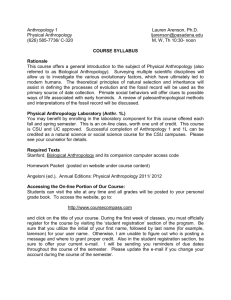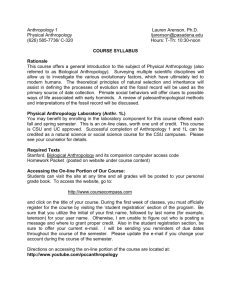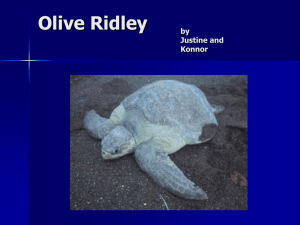syllabus - pantherFILE
advertisement
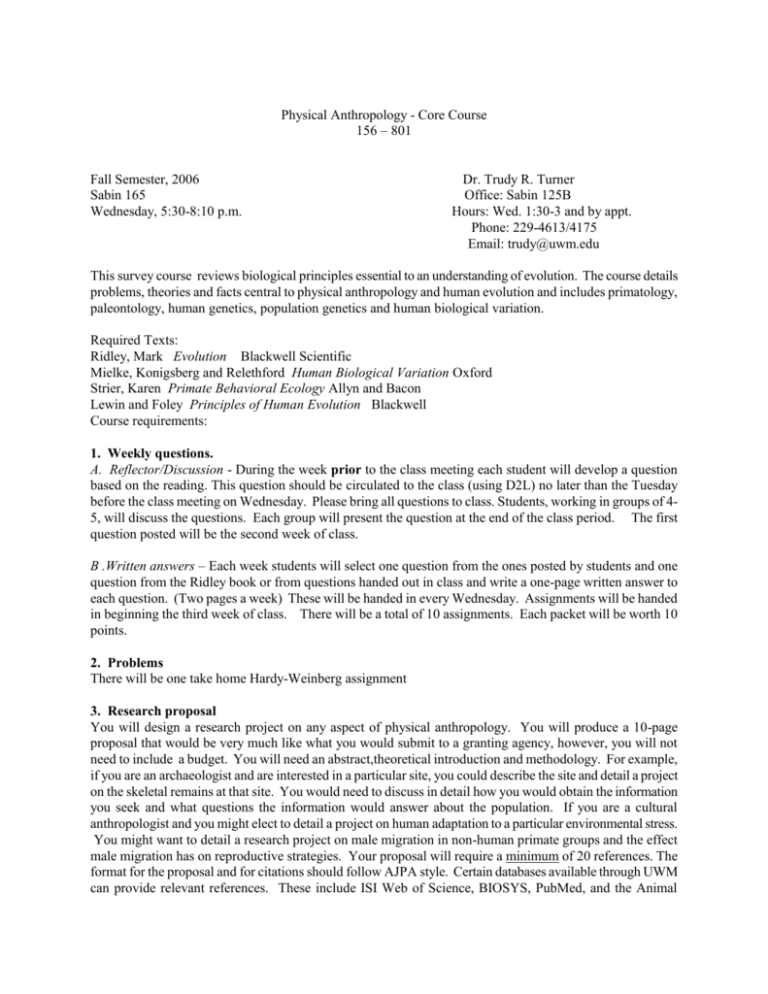
Physical Anthropology - Core Course 156 – 801 Fall Semester, 2006 Sabin 165 Wednesday, 5:30-8:10 p.m. Dr. Trudy R. Turner Office: Sabin 125B Hours: Wed. 1:30-3 and by appt. Phone: 229-4613/4175 Email: trudy@uwm.edu This survey course reviews biological principles essential to an understanding of evolution. The course details problems, theories and facts central to physical anthropology and human evolution and includes primatology, paleontology, human genetics, population genetics and human biological variation. Required Texts: Ridley, Mark Evolution Blackwell Scientific Mielke, Konigsberg and Relethford Human Biological Variation Oxford Strier, Karen Primate Behavioral Ecology Allyn and Bacon Lewin and Foley Principles of Human Evolution Blackwell Course requirements: 1. Weekly questions. A. Reflector/Discussion - During the week prior to the class meeting each student will develop a question based on the reading. This question should be circulated to the class (using D2L) no later than the Tuesday before the class meeting on Wednesday. Please bring all questions to class. Students, working in groups of 45, will discuss the questions. Each group will present the question at the end of the class period. The first question posted will be the second week of class. B .Written answers – Each week students will select one question from the ones posted by students and one question from the Ridley book or from questions handed out in class and write a one-page written answer to each question. (Two pages a week) These will be handed in every Wednesday. Assignments will be handed in beginning the third week of class. There will be a total of 10 assignments. Each packet will be worth 10 points. 2. Problems There will be one take home Hardy-Weinberg assignment 3. Research proposal You will design a research project on any aspect of physical anthropology. You will produce a 10-page proposal that would be very much like what you would submit to a granting agency, however, you will not need to include a budget. You will need an abstract,theoretical introduction and methodology. For example, if you are an archaeologist and are interested in a particular site, you could describe the site and detail a project on the skeletal remains at that site. You would need to discuss in detail how you would obtain the information you seek and what questions the information would answer about the population. If you are a cultural anthropologist and you might elect to detail a project on human adaptation to a particular environmental stress. You might want to detail a research project on male migration in non-human primate groups and the effect male migration has on reproductive strategies. Your proposal will require a minimum of 20 references. The format for the proposal and for citations should follow AJPA style. Certain databases available through UWM can provide relevant references. These include ISI Web of Science, BIOSYS, PubMed, and the Animal Behavior Citations available through Cambridge. Please consult with me before making the final selection of a topic. Research projects will be presented to the class during the last week. Your presentation should take no more than 10-12 minutes and you should use Power Point for your presentation. 4. Presentation of one recent journal article You will select one article from the journals listed below and present the article to the class. The articles should be published after January, 2004. You will give a 10 minute presentation of the articles during class. The articles should be about either primatology or human adaptability. There will be a sign-up sheet for the presentations. If you are unsure of the articles, please check with me. The following journals are acceptable to choose articles from: American Journal of physical Anthropology American Journal of human Genetics Human Biology Science Nature Nature Genetics Evolution Molecular Evolution Evolutionary Anthropology Folia primatologica Primates American Journal of Primatology International Journal of primatology Journal of human Evolution Behavioral ecology and sociobiology Human behavior and evolution American Journal of Human Biology Human Biology 5.Group presentation of historically important articles You will be given a list of articles/books that have had an important influence on physical anthropology. You and two to three other class members will form a small group and work together to lead the class in a discussion of the article. You will present three articles during the semester. You should be able to relate your article to your current reading. Grading: Weekly questions - 50% Genetics problems – 5% Research proposal – 25% Journal presentation – 5% Group presentation – 15% Sept 6 Introduction Ridley - Part 1 p.20 – 1,3; p.67 – 1,2,3,4;p. 87 – 2,4,6 Genetics Mielke – Chapter 1 and 2 Lewin and Foley – Chapter 1 For written assignment choose two questions from Ridley Sept. 13 The Study of Diversity Ridley - Part 2 p.131 – 1;p.149 – 1,3 Mielke – Chapter 1 and 2 Sept. 20 Evolutionary Processes Lewin and Foley – Chapters 2 and 3 Ridley - Part 2 p. 149 – 2; p.194-2.4; p.254-1;p.278-2,4,5 Ridley - Parts 3&4 p.314 – 1,2,4,6; p.336 – 1,2,4; p.368 – 2,5 p.396 – 2,6,7; p.424 – 1,2,3; p.461 – 1,2,3 Sept. 28 Measuring Evolutionary Processes Mielke – Chapter 3 Population Genetics Problem set handed out Oct 4 Evolutionary Theory/Classification/ Ridley - Parts 4 & 5 p.506 – 1,3,8; p.581 – 3,4,5 Genetics problems due Oct 11 Human Diversity Mielke – Ch. 4,5, 6, 7, 8 Oct 18 Human Variability Presentation of journal articles Mielke – Ch.9,10,11,12,13 Oct. 25 Primate Behavior Strier – entire book Nov 1 Primate Behavior Presentation of journal articles Nov 8 Early hominin evolution Nov 16 AAA Meetings Nov 23 Thanksgiving Nov 29 Early hominin evolution Dec. 6 Ethical issues in biological anthropology Paper presentations Dec. 13 Paper presentations Lewin and Foley Ch. 4, 8-13 Lewin and Foley – Ch.14 - 20 Important Historical documents: Evolutionary theory Mayr, E. 1963 Animal Species and Evolution Harvard Press Hamilton, 1974 The genetical evolution of social behavior J. Theoret. Biol 7:1-16 Trivers 1971 The evolution of reciprocal altruism Q. Rev. Biol 46:35-57 Kimura and Ohta 1974 On some principles governing molecular evolution Proc. Nat.Acad Sci USA 71:28482852 Kimura 1989 DNA and neutral theory Phil Trans. R Soc Lond B 312:343-354 Purvis and Harvey 1995 Mammal life history evolution: a comparative test of Charnov’s model J. Zool. Lond. 237:259-283 Stearns, S. 1992 The evolution of life histories Oxford Hill 1993 Life history theory and evolutionary anthropology Evol. Anthrop. 2:78-88 Wilson, EO 1975 Sociobiology Harvard Simpson 1951 The species concept Evolution 5:285-298 Gould and Eldridge 1977 Punctuated equilibria: the tempo and mode of evolution considered. Paleobiology: 3:115-151 Hennig 1965 Phylogenetic systematics Ann Rev Entemol 10:97-116 Manel, et al. 2003 Landscape genetics Trends in Ecology and Evolution 18:189-197 Primates Cartmilll 1992 New view on primate origins Evol Anthrop. 1:105-111 Kay 1997 Anthropoid origins Science 275:797-804 Van Hooff and van Schaik 1994 Male bonds: affiliative relationships among nonhuman primate males Behavior 130: 309-306 Smuts, et al. 1984 Primate Societies Harvard Alberts and Altmann 1995 Balancing costs and opportunities: dispersal in male baboons. Am Nat 145:279306 Altmann 1974 Observational study of behavior: sampling methods Behavious 49:227-265 Clutton Brock and Harvey 1977 Primate ecology and social organization J. Zool. Lond 183:1-39 Crook and Garlan 1966 On the evolution of primate societies Nature 210: 1200-1203 Hrdy The Woman that Never evolved Human Variation Bogin 1999 Evolutionary perspective on human growth. An nREv Antropol 28:109-153 Jablonski and Chaplin 2000 The evolution of human skin coloration J. Hum Evol 29:57-106 Templeton 1998 Human races: a genetic and evolutionary perspective Am. Anthropol. 100:632-650 Ober 1999 Studies of HLA, fertility and mate choice in a human isolate Hum Reprod Update 5:1336:103-107 Hawkes 1998 Grandmothering, menopause and the evolution of human life histories Proc Nat Acad Scie USA 95:1336-1339 Tishkoff and Verrelli 2003 Patterns of human genetic diversity Ann Rev Genomics hum Genet 4:293-340
